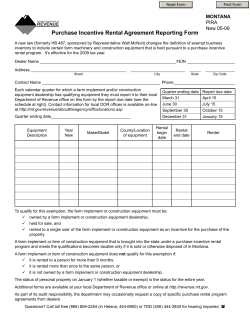
S M V
SAMPLE MEASUREMENT AND VERIFICATION (M&V) PLAN FOR BOB’S FARM ANAEROBIC DIGESTER GAS (ADG) SYSTEM Agreement # ADG-XXXX July 10, 2009 Submitted to: New York State Energy Research and Development Authority 17 Columbia Circle Albany, NY 12203-6399 and Bob’s Farm 1234 Smith Hill Rd Perry, NY 14530 Submitted by: TC Consulting Services 123 Green Power Drive Greenville, NY 12345 The meters, dataloggers, other equipment, methods and procedures described in this sample plan are representative examples of what could be used on an ADG project. NYSERDA does not endorse or guarantee their validity for any specific site. The ADG applicant is ultimately responsible for selection of the equipment, methods and procedures that are most appropriate for their site’s application. PROJECT PARTICIPANTS NYSERDA Project Manager Kathleen O’Connor x3422 kmo@nyserda.org ADG-to-Electricity Applicant (the “ADG Applicant” or the “farm”) Bob’s Farm Bob Smith 1234 Smith Hill Road Perry, NY 14530 123.456.7899 ADG Contractor Site Contact Bob Smith, Jr. Equipment Manager Bob’s Farm PO Box 456 Perry, NY 14350 123.456.7882 Email: Juniorbob@BobsFarm.com Digester System Vendor/Designer Anaerobic Digesters, Inc. Contact: Anne O’Robic 123 Main St. Anytown, NY 12875 123.123.1234 Email: aor123@ADI.com NYSERDA Technical Consultant (TC) TC Consulting Services Contact: Tim Conners 123 Green Power Drive Greenville, NY 12345 345.567.8900 Email: tc8900@TCSl.com NYSERDA CHP Website & Monitoring Contractor (CHP Website Contractor; Monitoring Contractor) Hugh Henderson CDH Energy Corp. PO Box 641 Cazenovia, NY 13035 315-655-1063 hugh@cdhenergy.com Bob’s Farm Introduction This plan describes the approach to monitor the performance of the anaerobic digester gas (ADG) system that is installed at Bob’s Farm (the “Farm” or the “Applicant”) to produce biogas and electricity. Biogas is used to drive an engine-generator to produce power that is consumed on site and/or exported back to the local utility. A monitoring system will be installed to measure and collect the data necessary to quantify the electric power produced by the engine-generator. The data will serve as the basis for payment of three (3) years of performance incentive payments, which the Farm has applied for under a Standard Performance Contract with NYSERDA based on a Total Contracted Capacity of 200 kW. ADG System Description The digester system at the farm was designed by Anaerobic Digesters, Inc. With the addition of the new engine-generator, the site will operate two 200 kW synchronous engine-generator systems with piping and controls that are installed in a new pole barn near the digester. All the electrical loads at the farm have been consolidated into one new 3-phase electrical service in order to accommodate the interconnection of the generator system. The electrical system includes controls to synch the generator to the grid as well as a protective relay and controls to automatically isolate the farm from the utility grid in the event of a utility power outage. The facility does not have the capability to run grid isolated. Table 1. Biogas Systems Installed at the Site Digester Anaerobic Digesters Plug Flow, Soft Cover, heated Feedstock Dairy Manure, 1000 cows Engine-Generator Biopower 2000 200 kW output on biogas 480 VAC, 3 phase Biogas Conditioning Mighty-Fine De-watering system Engine Backup/startup Fuel Propane Heat Recovery Use Digester heating Additional Heat Recovery None ADG M&V Plan 1 July 2009 Bob’s Farm Plate HX Partially Installed Engine Skid Flare Biogas Conditioning Skid Digester Digester and Biogas Flare Figure 1. Photos of System Components 600 A Generator Breaker 1200 A Main Breaker Main Electrical Panel Engine Control Panel Location for WG Power Transducer Figure 2. Photos of Electrical Panels ADG M&V Plan 2 July 2009 Bob’s Farm Figure 3 schematically shows the biogas system and engines. Biogas from the digester is either used in the engines or flared. (The biogas flare operates using a mechanically-actuated valve that vents biogas to maintain the digester at 1.5 inches of static pressure.) Biogas for the engine is de-watered and pressurized to 7 inches via equipment located on the biogas conditioning skid, which includes a variable speed drive (VSD) blower to maintain the 7 inch pressure set point. Only the new engine-generator will receive incentives through the ADG-to-Electricity Program. CO2 Sampling Biogas to flare Total biogas Digester Biogas to existing ADG engine Biogas to new ADG engine FGE Existing EngineGenerator New EngineGenerator Key - Blower Backup/startup fuel for engine from propane tank - Sensor Electrical Panel WG Loads Engine Control Panel Loads Utility Transformer Figure 3. Schematic of Biogas System Monitoring System Equipment, Installation, Operation, and Maintenance Figure 3 also shows the locations of the two data monitoring points which are used to measure system performance. A gas meter measures fuel gas input to the engine generator (FGE) and a power meter measures the kilowatts generated (WG). Information on these data points is shown in Table 2. ADG M&V Plan 3 July 2009 Bob’s Farm Table 2. Monitored Points for ADG System Point Type Pulse Pulse Point Name WG FGE Description Instrument Engine-Generator Power (of new engine only) Wattnode Model WNB-3Y-480-P w/ (3) CTs, 400 amp 10.2 Wh/pulse Dual Pulse Output (DPO) option with LCD display Roots/Dresser Rand Model 8C175 Meter temperature compensated to 60o F pressure = 7 inches 10 cubic feet per pulse Engine Biogas Flow (to new engine only) Engineering Units kWh/interval Expected Range 0-210 kWh/h (0-52.5 kWh / 15 min) ft3/interval 0 – 5000 ft3/h (0-1250 ft3/ 15 min) The electrical output of the new engine will be measured with a pulse-output power transducer (WG). This power transducer will include an LCD display and will be installed next to the electrical panel for the new engine by the electrical contractor. The transducer will be installed according to requirements in the “Wattnode Advanced Pulse Installation and Operation Manual” Rev. 2.34 (M5) (web links given in the Appendix). The meter will have its own circuit breaker or inline fuse to provide over-current protection on the voltage taps. The biogas input to the engine will be measured by a Roots gas meter (FGE) that provides pulse output proportional to the volume flow that is compensated for temperature to 60o F. The Roots meter will be installed in the vertical biogas pipe feeding the new engine in accordance with the provisions of the “Roots Meters Instruments Installation, Operations, and Maintenance” booklet ICM:02 10:03 (web links given in the Appendix), as part of the gas conditioning equipment that is provided by the digester system vendor, Anaerobic Digesters, Inc. The pipe will have a parallel bypass line with appropriate valves allowing for continuing use of the engine should the meter need to be removed for cleaning or repair. The oil level of the meter will be inspected at least monthly. A log of maintenance activities for the meter will be maintained at the site. The lower heating value for the biogas is estimated to be 550 Btu/ft3, based on past measurements of the CO2 content of the biogas. This value will be verified weekly based on measurements of carbon dioxide using a Fyrite Gas Analyzer Model No. 10-5032 for CO2 range 0-60%. The Farm staff will perform the CO2 tests and record the results in the project log. The backup/startup fuel flow (propane) will not be continuously metered at this site. However, the Farm will provide the propane delivery logs and summarize them in a spreadsheet table for the Annual M&V Report in order to account for periods when the backup/startup fuel is used. The propane tank does not serve any equipment except the new engine-generator. CDH Energy will install an Obvius AcquiLite datalogger to log the data from the two monitoring points listed in Table 2 (web links to datalogger details are given in the Appendix). The datalogger will be programmed to average or totalize data for each monitoring point for each 15-minute interval as appropriate. A record of all multipliers and datalogger settings will be maintained. The datalogger will be located in the engine room next to the control panel, and will be connected to an uninterruptible ADG M&V Plan 4 July 2009 Bob’s Farm power supply (UPS) to ensure the datalogger retains its settings and data in the event of a power outage. The UPS is capable of powering the data logger for at least one day. The Farm will provide a dedicated phoneline (or an Ethernet connection with fixed IP address) that will be used to communicate with the datalogger. The NYSERDA CHP Website Contractor (CDH Energy Corp.), will communicate with the datalogger nightly to extract monitored data from the datalogger and transfer the data to the NYSERDA CHP Website. If communications are lost, the Obvius datalogger is capable of holding at least 15 days of data. The Farm will be responsible for the cost to purchase and install the power meter (WG) and engine biogas meter (FGE). Management of Monitoring System Data (Farm/Applicant Responsibilities) The Farm will perform the following quality assurance and quality control measures to ensure the data produced from the monitoring system accurately describes system performance. On a daily basis, the farm equipment manager (or other specified employee) will perform inspections of the digester and engine-generator equipment and record findings into the project log. On a weekly basis, the farm equipment manager will perform inspections of the M&V meter installations and complete the routine maintenance on the meters, noting any abnormalities or unexpected readings. The farm will also maintain a weekly log of the cumulative power generation (kWh) and gas flow (cf or ft3) from the new engine in the event that data transfer to the NYSERDA CHP Website fails or other anomalies occur. On a weekly basis, the farm staff will review the data available on the NYSERDA CHP Website (chp.nyserda.org) to ensure it is consistent with their observed performance of the ADG system and logged readings. The farm will review the data using the reporting features at the website, including: • • Monitored Data – Plots and Graphs and RPS: Customer-Sited Tier Anaerobic Digester Gas-to-Electricity Program NYSERDA Incentive Program Reports In addition, the farm staff will also setup and use the email reports that are available at the CHP Website to help the track system performance, including: • • a periodic email report summarizing system performance and the estimated incentive, an email report sent out if data are not received at web site or do not pass the quality checks The website will automatically take the data collected from the datalogger and evaluate the quality of the data for each interval using range and relational checks. The expected ranges for the sensors (see Table 2) will be used for the range checks. The relational check will compare the kWh production data and gas production data for each interval to ensure both meters always provide non-zero readings at the same time (e.g., to detect if a meter has failed). Only data that pass the range and relational quality checks ADG M&V Plan 5 July 2009 Bob’s Farm are used in the incentive reports listed above. However, all hourly data are available from the NYSERDA CHP Website using the “Download (CSV file)” reporting option. In the event of a communications or meter failure, the farm will work with CDH to resolve the issue in a few days. If unanticipated loss of data occurs when the engine-generator continues to produce electricity, the farm will follow the procedures outlined in Exhibit D of their contract, i.e. using data from similar periods – either just before or after the outage – to replace the lost data. The farm understands that they can use this approach for up to two 36 hour periods within each 12-month performance reporting period. If more than two such data outages occur, the farm will provide information from other acceptable data sources (e.g., weekly recorded logs) to definitively determine the amount of power that was produced from biogas during the period in question. Annual M&V Reports The Farm will prepare the Annual M&V Report summarizing the monthly data over the 12-month performance period. The report will include a table showing the monthly kWh production, biogas used by the engine, and other data listed in Table 3. The farm may use the NYSERDA Incentive Program Reports found on the CHP website. Alternatively, they may provide their own summary of the data (using hourly CSV data downloaded from the Website) along with a narrative justifying why their data and calculations are more appropriate. The methods for calculating these values are provided below. Table 3. Summary of Monthly Data for Annual M&V Report Start Date of Reporting Period No of Days in Each Period Electricity Production, kWhgenerator Biogas Used by Engine (cubic feet) LHVbiogas (Btu/cf) Propane Used by Engine (gal) Biogas Energy Content, Qbiogas (Btu) Propane Energy Content, Qbiogas (Btu) Adjusted Electricity Production from Biogas kWhadjusted TOTAL ADG M&V Plan 6 July 2009 Bob’s Farm The Farm will calculate monthly values for lower heating value of the biogas (LHVbiogas), total energy content of the biogas (Qbiogas), total energy content of the propane (Qpropane), and adjusted kWh production (kWhadjusted) as follows. Monthly Biogas Lower Heating Value The readings of CO2 concentration in the biogas gathered weekly will be used to estimate the average monthly Biogas Lower Heating Value using the following equation: LHVbiogas = LHVmethane ⋅ (1 − FCO2 ) where: LHVmethane - lower heating value of methane (911 Btu/ft3 at standard conditions, 60 °F and 1 atm) FCO2 - fraction of biogas that is CO2 (average of readings for each month) Monthly Biogas Energy Content Calculate the average monthly Biogas Energy Content using the following equation: Qbiogas = CF ⋅ LHVbiogas where: CF - volume (cubic feet or ft3) of biogas in month Monthly Propane Energy Content Calculate the average monthly Propane Energy Content using the following equation: Btu LHV ⎤ ⎡ Q propane = Gallons ⋅ ⎢83,500 gal ⎥⎦ ⎣ where: Gallons - propane consumption in the period (gallons) Monthly Adjusted Electricity Production Calculate the monthly adjusted electricity production using the following equation: ⎡ ⎤ Qbiogas kWhadjusted = kWhgenerator ⎢ ⎥ ⎢⎣ Qbiogas + Q propane ⎥⎦ where: kWhgenerator - actual electricity production ADG M&V Plan 7 July 2009 Bob’s Farm In some cases, propane data may not be available on a monthly basis. In this event, the calculations to determine the adjusted electric production using Qpropane will be completed at the smallest possible interval (not greater than 12 months). Reasonable Electrical Efficiency The M&V Report will also provide a comparison of power output and fuel input for the engine to confirm their reasonableness. For instance the electrical efficiency – measured as power output (kWhgenerator) divided by the energy content of the fuel input (Qbiogas+Qpropane) in similar units and based on lower heating value – should be approximately 25% over any interval for the engine generator on Bob’s Farm. ADG M&V Plan 8 July 2009 Bob’s Farm Appendices Cut sheets and Manuals for: WattNode Meter Model WNB-3Y-480-P http://www.ccontrolsys.com/downloads/WattNodeWNBPulseDataSheet.pdf http://www.ccontrolsys.com/downloads/WNB-Pulse-Manual.pdf AquiLite Data Acquisition Server – A7801-1 http://www.obvius.com/documentation/Obvius/A7801Cutsheet.pdf http://www.obvius.com/documentation/Obvius/A7801Manual.pdf Roots Meter Series B3: 8C175 http://www.rootsmeters.com/internet/businessunits/flowcontrol/subunits/rootsmeters/Mete rsTechInfo.cfm?numPageID=1102 http://www.rootsmeters.com/internet/businessunits/flowcontrol/subunits/rootsmeters/iom.c fm?numPageID=5872 Fyrite Gas Analyzer http://www.bacharach-inc.com/PDF/Brochures/fyrite_gas_analyzers.pdf http://www.bacharach-inc.com/PDF/Instructions/11-9026.pdf Appendix A A-1 July 2009
© Copyright 2025











